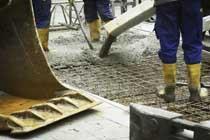Cement based on silicates and carbonates could reduce the carbon footprint of the contruction industry

Novacem, a spin-out company from Imperial College London's Incubator sector, has developed a 'green' cement that uses less energy to make than conventional Portland cement and absorbs a net amount of carbon dioxide, so potentially reducing the carbon footprint of the construction industry.
Conventional Portland cement used by the construction industry worldwide uses 3-4 gigajoules of energy per tonne manufactured, and releases between 650 and 800 kilograms of CO2. Every year more than 2.5 billion tonnes of Portland cement are produced with this number expected to increase to five billion tonnes per year by 2030.
Portland cement is made by heating limestone and clay in a kiln and then grinding the product with gypsum into a powder to make concrete, mortar and stucco. When mixed with water the cement undergoes hydration and hardens to form a strong, solid product with countless applications in construction, engineering, and even art.
Novacem's cement is made from magnesium silicate compounds and hydrated carbonates, which are heated to 180°C and pressurised to 150 bar. The silicates form hydroxides which soak up CO2 like a sponge and when heated at 700°C form magnesium oxide, with the CO2 released recycled back into the process.
The cement hardens by absorbing water, a hydration process. During this period the cement absorbs yet more CO2, locking it into the solid material and adding to its high mechanical strength. The detailed formula for Novacem cement is a trade secret, but Nikolaos Vlasopoulos, chief scientist at Novacem, explains that it will absorb between 100 and 450 kg of CO2 per tonne of cement produced, depending on its final composition. Novacem is currently refining the formula of the cement to achieve performance parity with Portland cement.






No comments yet